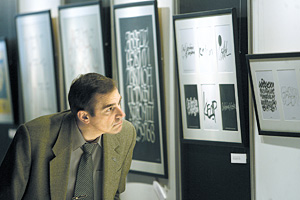Calligraphers to rewrite the Russian Constitution
The Moscow State Institute for International Relations (MGIMO) hosted a presentation of the International Exhibition of Calligraphy scheduled for September in Saint Petersburg. Nevertheless, its Moscow rehearsal gives a lively idea of the awesome sight in store for us in several months.
 From Sense to Symbol
From Sense to SymbolFor the first time ever Sokolniki MEC, supported by the MGIMO Alumni Association and by the Bolshoi Theater, has presented the exposition of works of the most famous calligraphy schools from all over the world. Slavonic writing from collections of the masters of the nib from Europe, Baltic States, the USA, Israel, China, Japan, Syria, and the United Arab Emirates; contemporary handwritten chefs d’oeuvre by leading calligraphers from Russia, Belarus, and Ukraine are displayed side by side with the beautiful museum samples of handwritten texts – rarities of the 10th-16th centuries. For example, one of the gems of the exposition is a manuscript of the Arkhangelsk Gospel of 1092, one of the earliest recorded handwritten documents of Old Russia.
According to Alexey Shaburov, General Manager of the project, member of the MGIMO Alumnae Association, and President of the Sokolniki MEC the idea is to revive the ancient art of beautiful handwriting, to promote calligraphy as one of the most poetic and inspirational means of teaching morality, to pass traditions, to contribute to the spiritual and cultural improvement of our great nation.
As we have learned, exhibition organizers are preparing a super surprise – the first handwritten calligraphic copy of the Constitution of the Russian Federation. If everything goes smoothly, the edition is expected to be presented personally to President Medvedev. However, the exposition will be available not only in Saint Petersburg. In October, it will go to Rostov-on-Don and in December – to the Russian State Duma in Moscow.
The great number of calligraphers from Belarus and Ukraine was just amazing. Some of the works truly mesmerized the audience. Let us here mention only one Belarus artist, Ruslan Naiden, whose work entitled “Autographs”, consisting of five sheets of paper, representing five phases of metamorphosis of a simple signature into a certain semblance of Malevich’s Black Square and vice versa is plainly astounding. It is like cloning the same handwritten letters with the constant addition of a new shade of meaning in each phrase. Simplicity of the concept, powerful dynamics, and titanic scrupulosity produce a tremendous impression.
It is hard to describe calligraphic works – you must see them with your own eyes. “Calligraphy is music appealing not to the ears but to the eyes.” Here are the names of some calligraphic texts represented at the exhibition: “Dance of Letters”, “Magdalene in a Desert”, “Love”, “Utopia”, “Not a Single Day Without a Letter”, “ABC Song…”
Moreover, the art of calligraphy is a powerful tool of fine motor skills development, which allows to instal the potential of the national and world culture right into the child’s mind. However, according to the organizers, the art of calligraphy provides an opportunity of human personality development at any age.
“Words come to an end, the sense lasts forever...”
For the largest part ill handwriting in the world is caused by hurry.
(Lewis Carroll)



